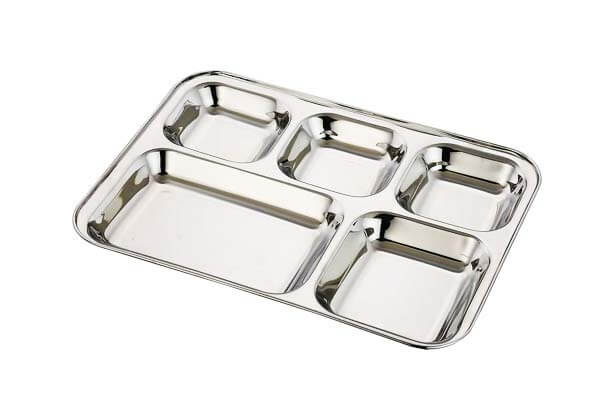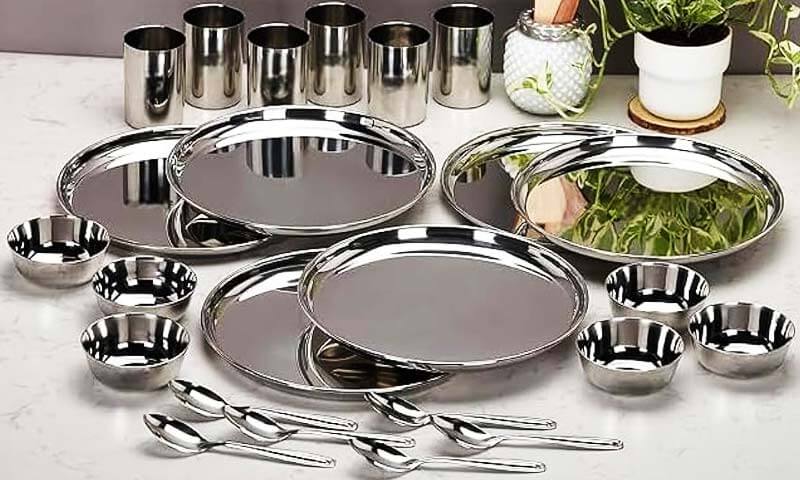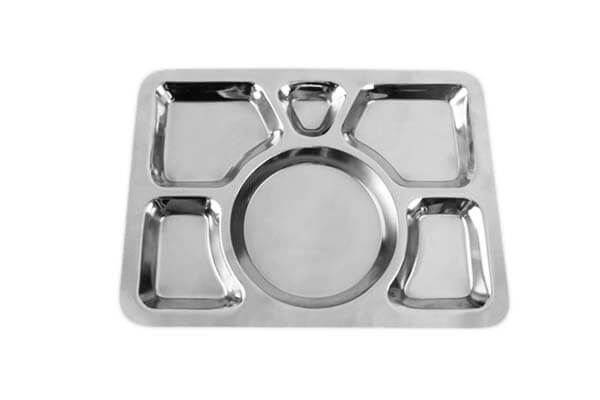1. Introduction: The Global Appeal of Stainless Steel Dinner Plates
In recent years, stainless steel dinner plates have become a highly sought-after solution for both personal and commercial use.
Whether in restaurants, households, or outdoor settings, the demand for durable, eco-friendly, and hygienic dinnerware continues to rise globally.
As environmental concerns grow and sustainability becomes a priority for consumers, stainless steel presents a reliable alternative to traditional disposable dinnerware.
Known for its strength, corrosion resistance, and ease of maintenance, stainless steel plates are the perfect option for modern dining needs.
In this article, we’ll explore the growing popularity of stainless steel dinner plates, examine their key benefits, compare them with other materials, and discuss their applications.
We’ll also highlight how DEZE, a leading manufacturer from China, is meeting the increasing demand for high-quality stainless steel plates internationally.
2. Why Stainless Steel Dinner Plates?
Durability and Longevity:
One of the primary reasons why stainless steel is so highly regarded is its exceptional durability.
Stainless steel plates can withstand the daily rigors of use without easily scratching, warping, or cracking.
This makes them perfect for both high-use environments like restaurants and casual, everyday use in homes.
Unlike other materials that may degrade over time, stainless steel retains its integrity for many years, offering both cost-effectiveness and value for money.
Hygiene and Safety:
Stainless steel is a non-porous material, meaning it doesn’t harbor bacteria or food particles like wood, plastic, or ceramics.
This makes it an excellent choice for health-conscious consumers looking for a safe, clean dining experience.
It’s easy to clean, and unlike plastic alternatives, it does not absorb odors or stain with food.
This high level of hygiene makes it ideal for both personal use and commercial environments such as hospitals, restaurants, and catering services.

Corrosion Resistance:
Stainless steel’s resistance to corrosion, particularly in environments with moisture, acids, or salts, makes it the ideal material for long-lasting dinnerware.
Whether exposed to water, acidic foods, or the rigors of outdoor use, stainless steel plates will maintain their integrity without rusting, staining, or losing their strength.
Eco-Friendly:
Sustainability has become a critical consideration for modern consumers.
Stainless steel plates are highly recyclable, contributing to reduced waste in landfills and the overall environmental footprint.
This is a stark contrast to disposable alternatives like paper and plastic plates, which contribute to environmental degradation.
Stainless steel’s recyclability ensures that it can be reused without loss of material quality, further promoting its sustainable appeal.
3. Manufacturing Process of Stainless Steel Dinner Plates
The production of stainless steel dinner plates involves a series of sophisticated manufacturing processes, beginning with the selection of high-quality stainless steel materials.
These materials are then melted, shaped, and molded into the desired forms using advanced techniques such as precision stamping, CNC machining, and polishing.
At DEZE, we use the latest technologies to ensure each plate meets international quality standards. Our process includes:
Material Selection
The first step in the manufacturing process is selecting the appropriate grade of stainless steel.
For dinner plates, food-grade stainless steel is commonly used due to its excellent corrosion resistance and safety for contact with food.
Different Grades of Stainless Steel Used in Dinner Plates
- 304 Stainless Steel: The most popular and widely used stainless steel grade, 304 offers excellent corrosion resistance, formability, and strength.
It is ideal for general-purpose dinnerware, suitable for both home and restaurant use. 304 stainless steel is resistant to most acids, including citric and lactic acids found in food.
304 Stainless Steel Plates - 316 Stainless Steel: Known for its superior corrosion resistance, 316 stainless steel contains molybdenum, which enhances its resistance to salt and chloride.
This grade is often used in environments with higher exposure to moisture, such as coastal areas or kitchens that process salty foods.
It is ideal for high-end commercial use and outdoor dining. - 430 Stainless Steel: This is a lower-grade stainless steel that is more affordable but still offers reasonable durability.
While it is less resistant to corrosion compared to 304 or 316,
it is a popular choice for budget-conscious consumers or for environments where the dinner plates will undergo less exposure to harsh conditions. - 201 Stainless Steel: A cost-effective alternative to 304 stainless steel, 201 stainless steel offers a good balance of strength and corrosion resistance.
However, it is prone to rusting in highly acidic environments and is typically used for low-cost, everyday dinnerware.
Cutting
Once the material is selected, sheets of stainless steel are cut into the desired shapes and sizes.
This can be done using various methods including shearing, laser cutting, or water jet cutting, depending on the manufacturer’s preference and available technology.
Forming
After cutting, the flat sheets are formed into plates. This typically involves deep drawing or stamping processes where a die shapes the metal into the form of a plate.
The edges may be rolled or folded to prevent sharpness and add strength to the plate.
Surface Treatment
Surface treatment is critical for achieving the desired finish on the plates.
Common treatments include polishing to achieve a shiny surface or brushing for a more matte look.
Electropolishing can also be applied to enhance corrosion resistance and provide a smoother surface.
Cleaning and Inspection
Following the forming and finishing processes, the plates undergo thorough cleaning to remove any oils, residues, or debris from manufacturing.
Afterward, each piece is inspected for quality assurance to ensure there are no defects such as cracks, scratches, or irregularities in shape or finish.
Packaging
Finally, once the plates have passed inspection, they are carefully packaged.
Depending on the intended market and use, packaging may range from simple bulk packing for industrial clients to more elaborate presentations for retail sales.
Throughout this process, manufacturers like DEZE would adhere to strict quality control standards
and possibly hold certifications that demonstrate their commitment to excellence and customer satisfaction.
These processes ensure that the final product meets high standards of performance and safety, making stainless steel dinner plates a reliable choice for consumers around the world.
4. Comparing Stainless Steel to Other Materials
When selecting dinnerware for residential, commercial, or hospitality purposes, it is essential to consider the material’s properties, cost, aesthetics, and durability.
Stainless steel is a leading choice for many reasons, but it’s important to understand how it compares to other materials like plastic, ceramic, melamine, and aluminum.
In this section, we’ll explore the key differences between stainless steel and these common materials, helping you make an informed decision for your needs.
Plastic vs. Stainless Steel
- Environmental Impact: Plastic plates are often seen as convenient, but they have significant environmental downsides.
Most plastics are not biodegradable, contributing to pollution and landfill waste.
Stainless steel, on the other hand, is fully recyclable, offering a more sustainable solution for those looking to minimize their environmental impact. - Durability: While plastic is lightweight and inexpensive, it does not have the longevity of stainless steel.
Plastic plates are prone to cracking, scratching, and staining over time,
while stainless steel plates retain their form and integrity, even with frequent use. - Health Concerns: Plastic plates can leach chemicals, especially when exposed to heat or acidic foods.
Stainless steel is a non-toxic, non-porous material that does not leach harmful substances,
making it a safer choice for food consumption.
Ceramic vs. Stainless Steel
- Weight and Strength: Ceramic plates, although aesthetically appealing, are often heavier and more fragile than stainless steel plates.
They are susceptible to chipping or breaking when dropped, whereas stainless steel is highly resistant
to impact and is unlikely to crack or break, even in the most demanding environments. - Aesthetics: Ceramic plates offer a more traditional, decorative appearance and can be customized with various glazes and designs.
However, they are heavier, which can be a disadvantage for casual or fast-paced settings.
Stainless steel, with its sleek and modern finish, complements both casual and formal dining settings and is available in various finishes, from matte to highly polished. - Cleaning and Maintenance: While ceramic plates can be easily cleaned, they are more prone to staining, especially with brightly colored or acidic foods.
Stainless steel, by contrast, is non-porous and resistant to stains, making it easier to clean and maintain in the long term.
Melamine vs. Stainless Steel
- Heat Resistance: Melamine is a plastic-based material known for being lightweight and inexpensive.
However, it does not handle high temperatures well and can melt or warp when exposed to hot food or beverages.
Stainless steel, with its high heat resistance, can withstand both high temperatures and cold environments without any risk of damage. - Durability and Scratch Resistance: Melamine is softer and more prone to scratching than stainless steel, especially when subjected to frequent use.
Stainless steel plates can withstand daily wear and tear, maintaining their smooth finish over time. - Safety Concerns: When melamine is exposed to high heat, it can release harmful chemicals, especially when used with hot food.
Stainless steel is a safe, non-toxic option, making it the preferred choice for those concerned about long-term health and safety.
Aluminum vs. Stainless Steel
- Strength and Durability: While aluminum is lightweight and resistant to corrosion, it is not as strong as stainless steel.
Stainless steel is known for its superior tensile strength and resistance to scratches, dents, and impacts.
Aluminum plates, although durable, are more susceptible to bending and damage over time compared to stainless steel. - Weight and Portability: Aluminum is lighter than stainless steel, which can be an advantage in some situations like travel, camping, or outdoor use.
However, the strength and sturdiness of stainless steel plates provide more versatility and longevity for regular use in restaurants or homes. - Corrosion Resistance: Both stainless steel and aluminum offer excellent corrosion resistance,
but stainless steel performs better in highly acidic environments or when exposed to salt, making it ideal for coastal areas or in places with high humidity.
5. Design and Aesthetics: Elevating Your Dining Experience
Stainless steel dinner plates aren’t just practical—they’re stylish too. With their sleek, polished appearance, they can complement both casual and formal dining settings.
Whether you’re hosting a dinner party, running a restaurant, or enjoying a family meal, stainless steel plates add a modern, sophisticated touch to the dining table.
DEZE offers a wide range of stainless steel designs to suit different tastes and preferences.
From matte finishes to polished looks, our plates can be customized in shape, size, and texture, allowing you to tailor them for specific occasions or match your home or restaurant decor.
Our customization services also allow businesses to incorporate their logo or branding on the plates for a personalized touch.
6. Applications of Stainless Steel Dinner Plates
Stainless steel dinner plates have a wide range of applications due to their durability, ease of maintenance, and aesthetic appeal.
Below are some of the key applications where stainless steel dinner plates are commonly used:
Residential Use
In homes around the world, stainless steel dinner plates are becoming increasingly popular for everyday use.
They offer a sleek, modern look that can complement any kitchen decor while providing a practical solution for families looking for durable and easy-to-clean tableware.
Restaurants and Catering Services
The hospitality industry often favors stainless steel dinnerware for its robustness and ability to withstand frequent use and washing.
Stainless steel plates are ideal for restaurants, cafes, and catering services
because they maintain their appearance over time and are less likely to chip or break compared to ceramic or glass alternatives.

Outdoor and Travel
Due to their lightweight yet sturdy construction, stainless steel plates are perfect for outdoor activities such as picnics, camping, and travel.
They are resistant to rust and corrosion, making them suitable for use in various weather conditions and environments.
Cultural and Religious Events
In many cultures, especially in India, communal eating is a tradition, and stainless steel plates (often referred to as thalis) are commonly used during festivals and religious ceremonies.
These plates are not only functional but also hold cultural significance.
Commercial Kitchens and Food Service Establishments
Commercial kitchens require durable and reliable dinnerware that can handle high-volume usage.
Stainless steel plates meet these needs and are often chosen for their resistance to staining and their ability to be sanitized effectively.
Special Occasions and Fine Dining
While often associated with casual dining, stainless steel plates can also be found in fine dining establishments
where chefs may choose them for their contemporary look and ability to enhance the presentation of certain dishes.
Health Care Facilities
Hospitals and care homes may opt for stainless steel dinner plates because they are easy to clean and sanitize, reducing the risk of cross-contamination and infection spread.
Educational Institutions
Schools and universities might use stainless steel plates in cafeterias for their durability and safety features, which are important considerations in busy dining halls with high student traffic.
7. How DEZE Stands Out as a Leading Manufacturer of Stainless Steel Dinner Plates
As a top stainless steel dinner plate manufacturer, DEZE stands out for its commitment to quality, sustainability, and customization.
With years of experience in producing high-quality stainless steel products, DEZE has earned the trust of clients worldwide.
Our state-of-the-art production facilities and expertise ensure that each plate is crafted with precision and care.
We also offer a range of customization options, allowing clients to personalize their stainless steel plates to meet specific needs and preferences.
Whether you need bulk orders for restaurants or bespoke designs for personal use, DEZE provides the ideal solution.
8. Applications of Stainless Steel Dinner Plates in International Markets
DEZE’s stainless steel dinner plates have been successfully exported to numerous international markets, including Southeast Asia, North America, and Europe.
Our plates are used in diverse settings, from luxury hotels and restaurants to local eateries and homes.
By understanding the unique needs of different regions, DEZE ensures that we provide high-quality, reliable, and stylish dinnerware to global customers.
9. Conclusion: Why Stainless Steel Dinner Plates Are Here to Stay
In conclusion, stainless steel dinner plates represent the future of modern dining.
With their unparalleled durability, safety, eco-friendliness, and aesthetic appeal, they continue to gain popularity worldwide.
Whether for personal use or business needs, investing in stainless steel dinner plates offers long-term value that benefits both your dining experience and the environment.
At DEZE, we’re dedicated to providing top-quality stainless steel dinner plates that meet the highest standards.
Get in touch with us today to explore our range of products, and customization options, and discover how we can cater to your needs.




